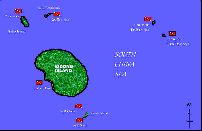 click on map to enlarge
click on map to enlarge
TENGGOL ISLAND SITES BIDONG ISLAND SITES REDANG ISLAND SITES
The boats we see now scattered in the bay of the main island are sunk by those who survived. Dozens of them, some in fair condition and recognizable while some are so eroded that only the engines are left sitting there upright on the shallow sandy bottom. These wrecks are resting in the calm, sheltered waters and having being there for 20 years or more, are now covered with marine growth with a good mixture of soft and hard corals. Small fishes abound, they are also home to moray eels and stingrays. This is a good site for a restful dive with lots to explore. Depths 15 to 50 feet (5 to 15 meters)
The northern end of this island is teeming with fish of many kinds. Predominantly yellowtail fusiliers and rabbitfish, pelagics like rainbow runner, kingfish, barracuda and jacks are often sighted in schools. Bottom is rocky down to 20 meters. Depths 30 to 70 feet (10 to 20 meters)
Rocky outcrops with a narrow channel in between. Usually mild currents drift through the channel. Good fish and coral life. Surprise encounters include large kingfish, giant groupers and large schools of barracuda and jacks. Depths 20 to 60 feet (6 to 18 meters).
A very exposed islet east of main Bidong, it got its name from the fishermen of long ago when sharks were abundant. The northeastern point is rugged and plunges underwater to a beautiful coral garden. Excellent site for both coral and fish life. Seen often are barracuda, trevally, rainbow runner, bat fish and dozens of giant humphead parrotfish. Depths 30 to 80 feet (10 to 24 meters)
The rocky western point extends down underwater for quite a distance in the channel down to 24 meters. Aptly named for the dense schools of fusiliers regularly found there. Visibility is usually good at 10 to 15 meters. Occasionally, visibility can be as low as 5 meters. Depths 15 TO 50 feet (5 to 15 meters).
The straits between main island Bidong and Karah. Persistent current streams through the channel bringing rich waters to a submerged reef. Prolific coral garden based itself on large granite boulders. Good site for uncommon reef fish like the clown trigger and the reticulated angel. Predators like barracuda and jacks are found swimming over the reef. Depths 30 to 105 feet (10 to 30 meters)